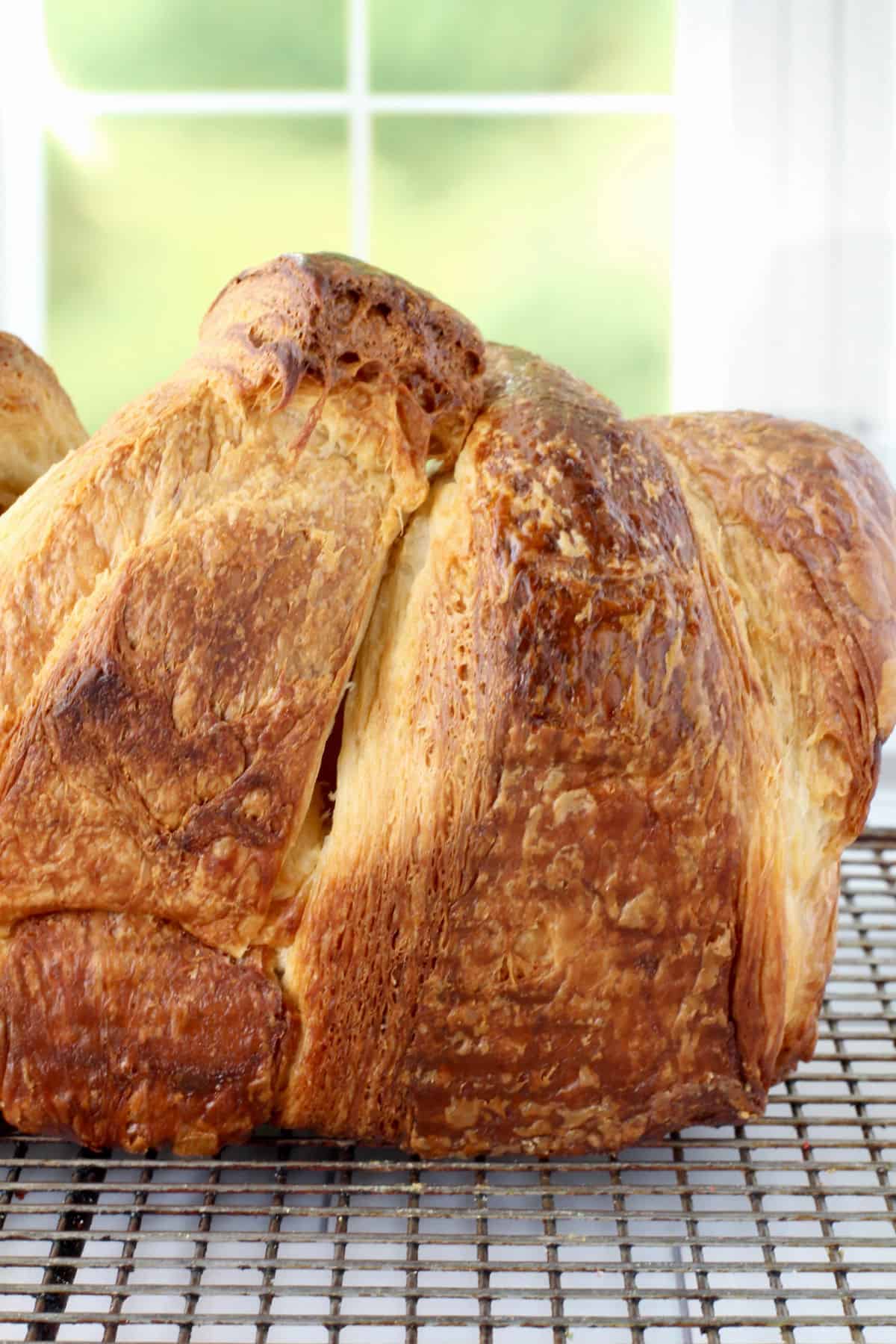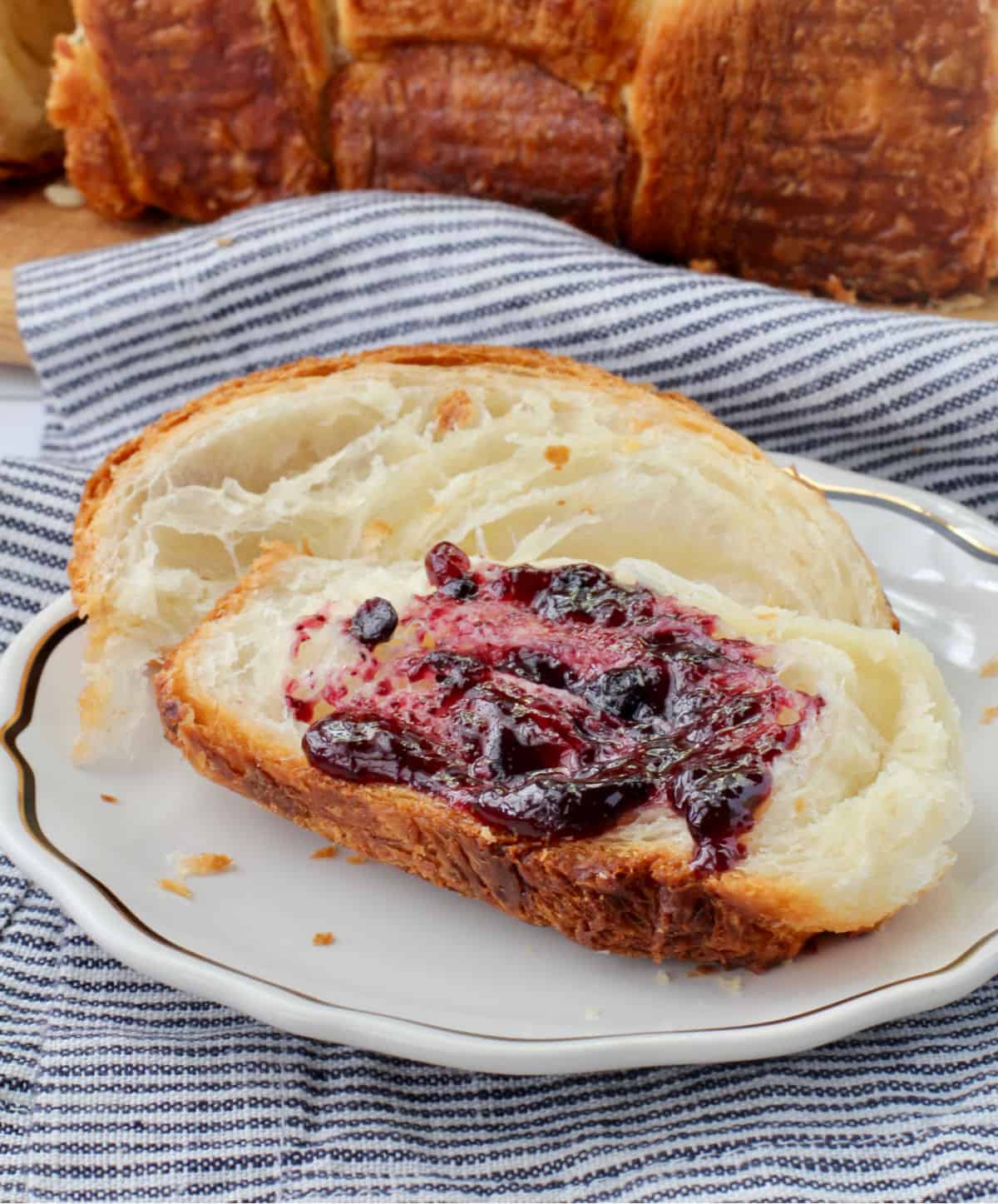This croissant bread is crispy and flaky on the outside and light and layered on the inside. You'll love peeling off layers of this amazing bread and spreading them with jam.
You can also just slice this bread and get creative. You don't need any butter because this bread is layered in butter before baking, just like a croissant.
This bread can be used for making any croissant-style sandwich, such as chicken salad, BLT or Club, a breakfast sandwich, or an egg salad sandwich.
I'm sure a grilled cheese sandwich would be pretty amazing too. This loaf disappeared too quickly for me to have a chance to try it.
This croissant bread would definitely be amazing in and add a whole new dimension to a breakfast strata, a French toast casserole, a broccoli and bacon breakfast casserole, or a bread pudding.
Yes, this bread is a bit of a project, but it's totally worth it. You can either spend one (very) long day making this loaf, or spread the process out over three days, beginning in the evening of the first day by mixing the dough, laminating the dough the second day, and shaping and baking the bread on the third day, which is what I chose to do.
Every time I make laminated dough, I learn something new and get better at it. If you're intimidated by laminating dough, trust me, the process becomes easier and easier.
By the way, you can use this dough for making actual croissants, croissant muffins, and Danish pastries too. Consider it a small batch master recipe!
I learned a few new techniques for laminating dough this time around, especially using a folding technique to add a few more layers of lamination at one time. You will use this technique on the second and fourth laminations.
I'm trying my best to describe how to prepare and laminate this dough. If you're confused, please drop me a question!
What is Laminated Dough?
It's dough that contains many thin layers of butter or another fat in between thin layers of dough. It's created by rolling out, folding, and rerolling the dough several times after encasing the butter/fat in the dough. It's what is used to make puff pastry (without yeast) and croissant or Danish pastry dough (with yeast).
Professional bakers use a dough sheeter, while the rest of us home bakers use a rolling pin.
The first time I tried it, butter spurted out everywhere and I though I was a failure, but miraculously, the results were delicious, so don't despair.
How To Make This Croissant Bread:
First, Make the dough by mixing bread flour, granulated sugar, instant yeast, salt, butter, and cold milk in a stand mixer until the dough is smooth and elastic. Put the dough into a greased bowl or dough rising bucket, cover it, and put it in the refrigerator overnight.
The next morning, make the butter block by combining some cold butter and flour and forming it into a rectangle. You could also let the butter soften and then mix it with the flour, but then you'd have to re-chill it. Instead, I like to grate the cold butter with a box grater, toss it with the flour, and then bring the mixture together with my hands or a wooden spoon.
Once you combine the butter and flour, form it into a rectangle or block and encase it in the rolled out dough.
Photo 1: Roll out the dough into a large rectangle. Then form the butter block into a rectangle that is half the size of the dough and transfer it to the bottom half of the rolled out dough.
Photo 2: Enclose the butter block by folding the dough over the butter and sealing the edges and tucking them under to enclose. Refrigerate the dough for about 15 minutes to chill before continuing.
Photo 3: Roll out the dough and fold the dough into thirds like a letter. Refrigerate.
Photos 4 and 5: Roll the dough out again and then fold it like an according to create four layers. Chill the dough again.
Photo 6: Roll the dough out again and then fold it like a letter and then chill it again. After that, roll it out and fold it into fourths (see photo 5) and chill. At this point, you can chill the dough overnight and make the bread the next morning.
Photo 7: Finally, roll the dough out once again and cut it into five strips, roll them up into coils, and place them seam side down into a loaf pan and let them rise until doubled.
Once the dough has doubled, bake the bread!
Note: To fold the dough into fourths, you can either fold it in half and then fold the top and bottom under while flipping the dough... or, you could fold the outside edges in with the meeting point being at the 1/3 point, and then folding the whole thing in half (I know that sounds confusing, see photo #5).
Tips for Success:
First, be patient. Don't worry too much if bubbles form on the surface of the dough while you are rolling it out. If you get some bubbles, you can poke them with a toothpick and then lightly brush them with extra flour.
For the final overnight chilling, be sure to wrap the dough with enough extra oiled plastic wrap to prevent it from "kicking off the covers" and exposing the dough to dry it out. Place the dough into a container such as a hotel pan or a casserole so that it will remain enclosed and covered.
Make sure the internal temperature of the loaf reaches 195 degrees F before turning off the oven. Otherwise the interior of the bread will not be fully baked and will collapse as the bread cools. Be sure to leave the loaf in the oven with the door slightly ajar as it cools for the first fifteen minutes after baking.
As you're rolling out the dough, I recommend flipping it over several times as you go. This way, each layer gets rolled out evenly.
Be sure to have patience and try to make sure that you are continuing to maintain the shape of a rectangle as you're rolling the dough. Lightly flour your work surface but be careful about using too much extra flour.
My favorite tool to roll out chilled dough is a marble rolling pin. I love that it's heavy, cold, and doesn't cause the dough to stick. I typically use it only for laminated dough, but it's worth having one.
You can keep this bread at room temperature for about three to four days. This bread also freezes very well once it has cooled. I love reheating slices and then spreading them with jam. So good. We pretty much plowed through this loaf in no time.
You can use either salted or unsalted butter for the butter block. I prefer salted butter for the flavor.
More of my Laminated Bread Recipes:
Laminated Bread from the Bread Bakers:
- Cranberry Brie Appetizer Pinwheels from A Messy Kitchen
- Croissant Bread from Karen's Kitchen Stories
- Herbed Cheese Scrolls from Sneha's Recipes
- Kakaós Csiga from Passion Kneaded
- Rough Puff Pain au Chocolat from Food Lust People Love
#BreadBakers is a group of bread loving bakers who get together once a month to bake bread with a common ingredient or theme. Follow our Pinterest board right here. We take turns hosting each month and choosing the theme/ingredient.
Croissant Bread

Ingredients
- 283 grams (2 1/3 cups) bread flour
- 33 grams (1/6 cup) granulated sugar
- 7 grams (2 teaspoons) instant yeast
- 5 grams (1 1/4 teaspoons) fine sea salt
- 35 grams (2 1/2 tablespoons plus 1/2 teaspoon) unsalted room temperature butter
- 180 grams (1/2 cup plus 1/3 cup) cold whole milk
- Egg wash for the final loaf (egg plus milk or cream)
- 226 grams (2 sticks) unsalted or salted butter
- 35 grams (1/3 cup) bread flour
Instructions
- In the bowl of a stand mixer, combine the bread flour, sugar, yeast, salt, butter, and milk on low for about three minutes. Switch the speed to medium and continue to mix for an additional three minutes. Place the dough into an oiled bowl, cover with plastic wrap, and refrigerate overnight.
- The next morning, grate the butter with a box grater or a food processor for the butter block into a medium bowl. Toss the butter with the flour and mix with your hands, the food processor, or a wooden spoon. Place the butter and flour onto a sheet of parchment paper and form it into a six inch by nine inch rectangle. Wrap it in the parchment and refrigerate for about 20 minutes.
- On a lightly floured work surface, roll the chilled dough out into a 10 inch by 12 inch rectangle, about 1/3 inch thick. Place the butter block on the lower half of the rolled out dough. Fold and stretch the top half of the dough over the butter and pinch the edges together. Tuck the edges under to enclose the butter block.
- Roll the dough out into a 13 inch by 18 inch rectangle. Fold the dough like a letter, into 3 layers. Refrigerate for 15 to 20 minutes.
- Remove the dough from the refrigerator and roll the dough out into a 10 inch by 14 inch rectangle on a lightly floured work surface, placing the short sides on the left and right. Fold 1/4 of the the left side over itself. Fold the right side to meet the left side. Fold the right side over to the left side so that you have four layers. Refrigerate for 15 to 20 minutes. Be sure to try to keep the dough squared in the corners as you work with it.
- On a lightly floured work surface, roll the chilled dough out into a 10 inch by 14 inch rectangle and fold it into thirds, like a letter that you might put into an envelope. Cover and chill in the refrigerator for 15 minutes.
- Roll the dough out into a 10 inch by 14 inch rectangle and then repeat step 5. After this final fold, cover the dough with oiled plastic wrap so that it can expand without becoming uncovered and refrigerate it overnight.
- Butter a 9 inch by 5 inch bread pan. Remove the dough from the refrigerator and roll it out into a nine inch by 12 inch rectangle. Using a pizza wheel or chef's knife, cut the dough into 5 strips, about 1 3/4 inches wide, and roll each up and place them, seam side down, into the bread pan. Cover with plastic wrap and let rise until doubled, about 45 minutes to 2 hours depending on the temperature of the dough. Heat the oven to 375 degrees F.
- Right before baking, whisk together an egg with cream or milk and brush it over the top of the dough.
- Bake the loaf in the oven for 40 to 50 minutes, until the middle is 195 degrees F. If the loaf gets too brown, tent with foil while baking (be sure to monitor). Once the loaf is done, turn off the oven and prop the door open for about 15 to 20 minutes with the loaf still in the oven.
- Remove the loaf from the oven and turn it out onto a wire rack and let continue to cool.
Nutrition Facts
Calories
217Fat (grams)
14 gSat. Fat (grams)
9 gCarbs (grams)
19 gFiber (grams)
1 gNet carbs
19 gSugar (grams)
5 gProtein (grams)
3 gCholesterol (grams)
47 mgInspiration from Food 52, Sally's Baking, and King Arthur Baking.










My hubby love's croissants and these look so scrumptious!
ReplyDeleteAbsolutely awesome post!
ReplyDeleteThank you so much Sally!
DeleteBrilliant, flaky bread! It looks divine!
ReplyDeleteThanks Kelly!
DeleteThe Queen of Bread! This looks fantastic and has me wanting to get back to bread baking.
ReplyDeleteAwww. Thank you!
DeleteKaren, this looks fabulous. I'll have to put in on my to-bake list!
ReplyDeleteThank you so much Judy!
DeleteThat crumb is absolutely gorgeous! No wonder it didn't last long. I will try your folding steps the next time I try laminated dough
ReplyDeleteThank you! It definitely produces more layers!
DeleteWhat a fabulous loaf, Karen! So many flakey layers!
ReplyDeleteThanks Stacy! I was pretty proud of this one.
DeleteScrolled to hunt for a picture of the inside of the bread. This one looks insanely delicious, and like real springy-bready if that's a real word. Once I remember in UAE having bread that appeared more like it had the consistency of cake. - Yours looks super delicious.
ReplyDeleteThank you!
Delete